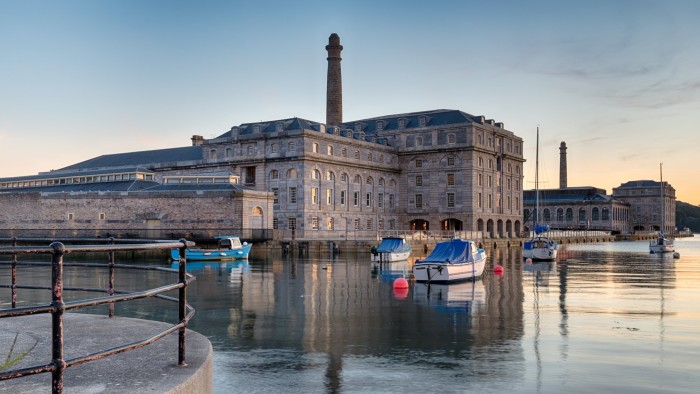Unlock the Editor’s Digest for free
Roula Khalaf, Editor of the FT, selects her favourite stories in this weekly newsletter.
The British Navy built the Royal William Victualling Yard in Plymouth in the wake of the Napoleonic wars to stock its warships with food and drink. Nearly two centuries later, the yard contains apartments, restaurants, a co-working space and gym, and an Everyman cinema.
King William IV, known as the “sailor king”, could not have imagined how his grand 16-acre fort, surrounded by high stone walls, would come to be used. It did not even appear likely a few decades ago, when Plymouth’s decline as a military base had taken a heavy toll on the city centre. Having been bombed and then reconstructed after the second world war, it was in decline.
Richard Stevens, chair of the Devon chamber of commerce, says the city was “pretty down on itself” after decades of “happiness sort of dissipating”. It still feels sad along Union Street, the historic thoroughfare linking Plymouth’s centre to the Devonport dockyards. The clubs where sailors used to party are boarded up and many shops are derelict.
Turn down Durnford Street, where Georgian houses formerly owned by naval officers now sell for up to £750,000, pass through the gates of Royal William Yard, and things pick up. Lunchtime diners fill the restaurants set around a ferry and sailboarding dock, and architects, lawyers and an array of professionals work in offices built into former warehouses.
This adaptation of former industrial buildings and disused land is not of the scale of the 67-acre King’s Cross development in London, which has drawn companies such as Google and Meta. But Royal William Yard has lessons for smaller cities without the same public resources and wealth as London, or the assurance of rising land values.
One is the need for imagination. Royal William Yard had plenty counting against it when the (later abolished) regional development authority started to restore its dilapidated Grade I and II listed buildings in the 1990s. It was on the edge of Plymouth in a deprived district, consisted of empty buildings and was behind a wall guarded by sentries.
Urban Splash, a Manchester developer involved in regeneration projects in the north, later converted the buildings and still manages the yard. Manchester’s revival gave it confidence. “There was a stock of amazing buildings lying empty [in Manchester] that others said would never work. They regarded us as lunatics,” says Tom Bloxham, Urban Splash’s co-founder and chair.
As other cities have found, converting old buildings instead of demolishing and replacing them is expensive (any alteration to the yard’s listed structures must be approved) but it can pay dividends. Just as many professionals like living in Victorian houses, their firms are drawn to urban warehouses more than suburban blocks.
A second lesson is patience. Urban Splash has been at work on Royal William Yard since 2004 and is not finished. It needs to rethink the buildings constantly as working and living patterns evolve. Restaurant chains no longer want to occupy such big spaces and firms have taken small offices on short leases offered by Block, a Devon co-working and office space firm.
Patience is also vital in cities where regeneration takes a long time to be rewarded. Urban Splash made a loss of £6.9mn in 2023 after a modular housing subsidiary collapsed (it also faces a £48mn cladding claim, which it contests). “Costs have gone up and values down. It is very hard and sometimes we need public backing to make projects work,” Bloxham says.
But as London’s axis has shifted to the east, the yard is influencing Plymouth’s future. The city now wants to convert much of its former civic centre, along with the vacant spaces above shops, into apartments. The project has shown that people can be attracted to the centre by a combination of living, working and leisure space, rather than driving in from outside to shop.
This does not make Royal William Yard exemplary. Given its history and high walls, it has aspects of a gated community, albeit one that wants all to enter. Andrew Carter, chief executive of the Centre for Cities think-tank, describes it as an example of an “island of difference” within a city, rather than a regeneration project that changes an entire metropolis.
It feels like that on Union Street, but it might equally have felt hopeless 30 years ago in Royal William Yard. Stevens cites a list of new initiatives that build on the yard’s legacy and calls Plymouth “a regenerative city. It is regrowing.” Imagine that.



